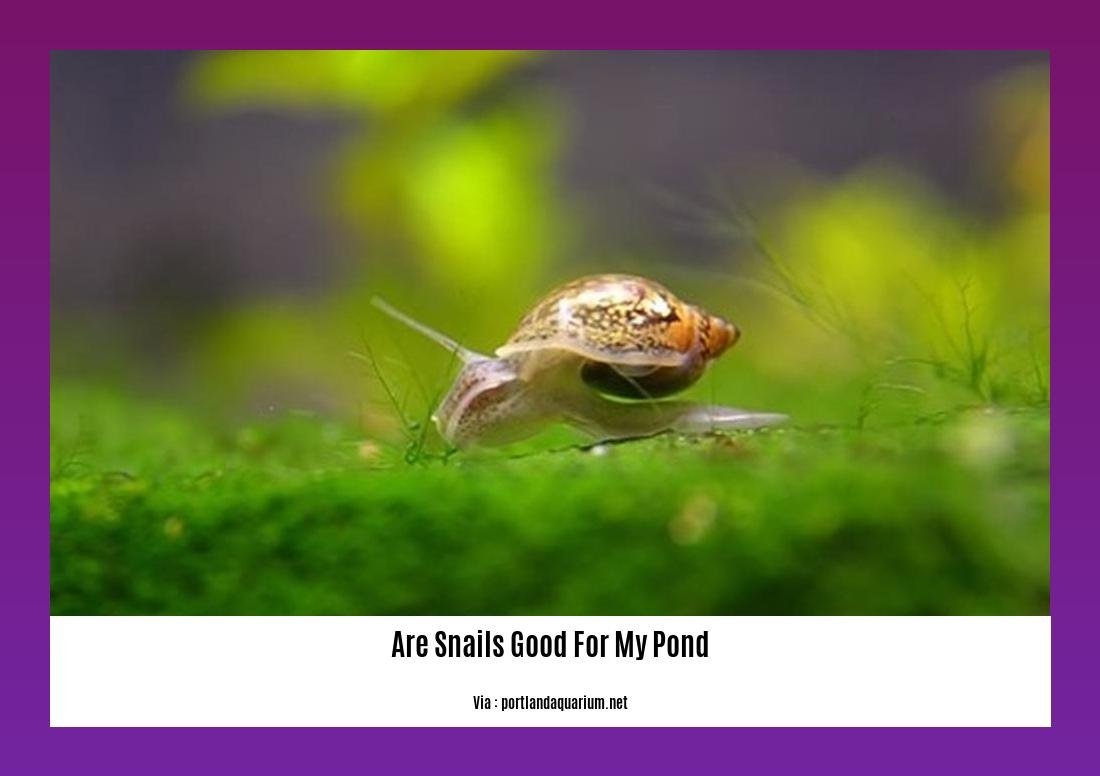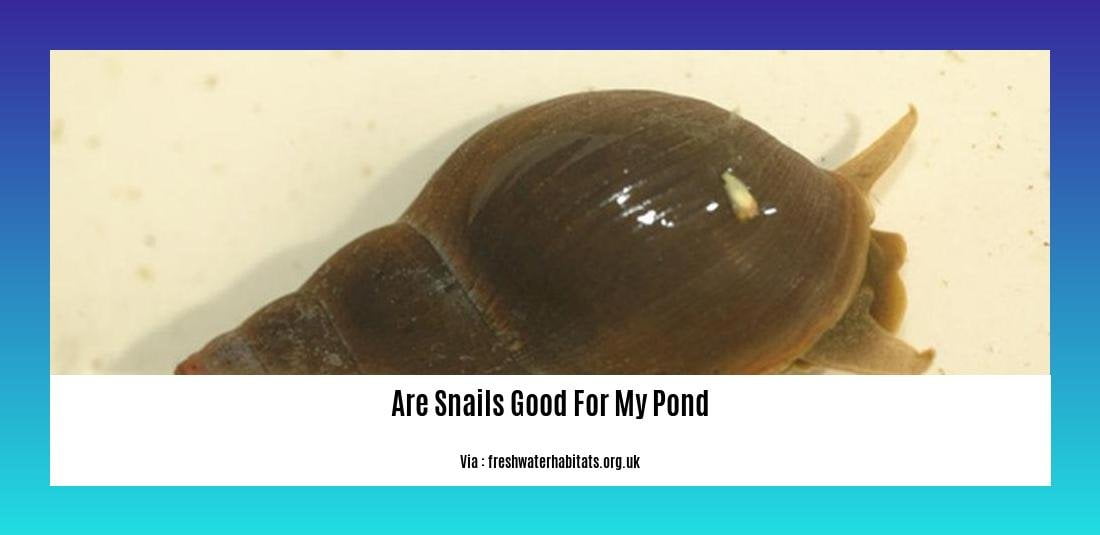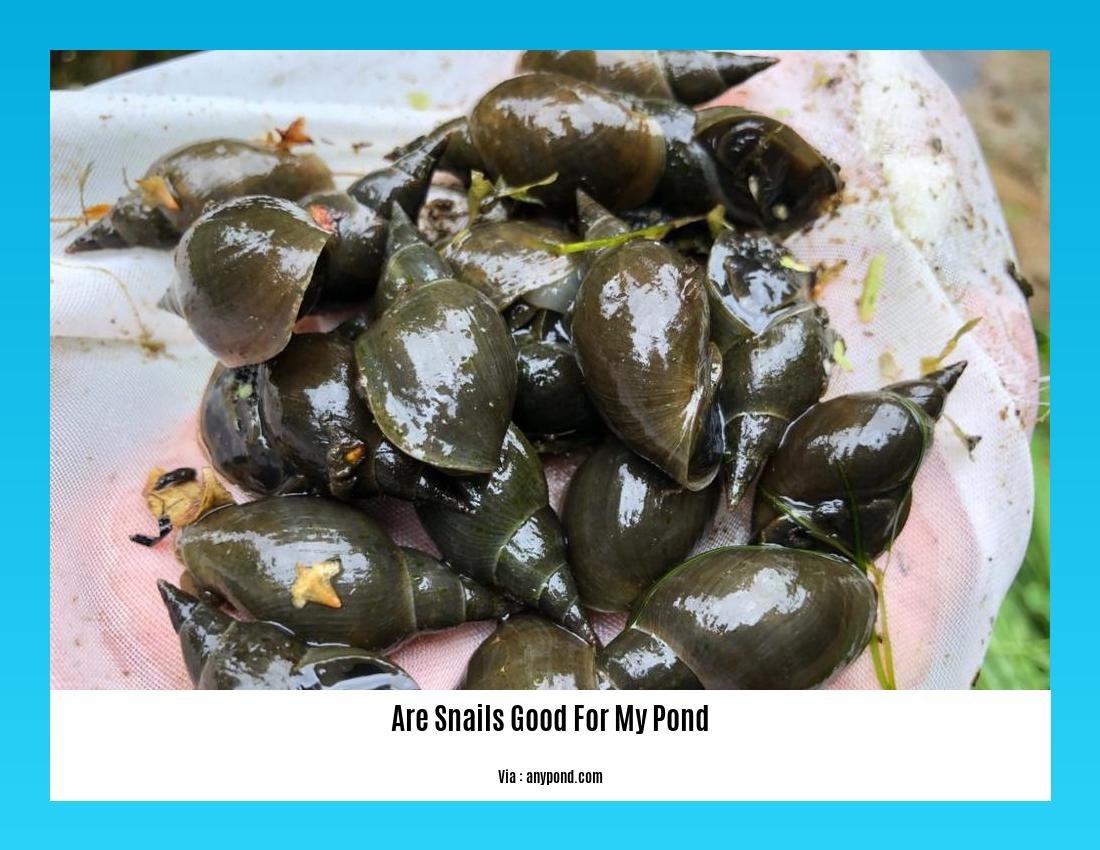Are snails good for my pond? This question often arises among pond enthusiasts and gardeners alike. In this article, “Exploring the Benefits of Snails in Your Pond: Are Snails Good for My Pond?”, we will delve into the world of aquatic ecosystems and shed light on the role of snails in maintaining a healthy and balanced environment. As a seasoned pond enthusiast and gardening expert, I bring a wealth of knowledge and experience to this topic. Join me as we uncover the numerous benefits that snails bring to your pond, as well as how to effectively manage their populations.
Key Takeaways:
- Pond snails can play an important role in maintaining a healthy pond ecosystem.
- They help keep the pond clean by grazing on algae.
- Pond snails aid in nutrient cycling by feeding on detritus and releasing nitrogen from sediment.
- They act as natural janitors by feeding off sludges and other wastes.
- Pond snails also aid in filtration by turning sediments.
- Some people use snails as decorative animals for ponds.
- Trapdoor snails are particularly effective in keeping pond water clean and reducing levels of ammonia.
- Snails can be necessary to create a balanced and natural ecosystem in large ponds.
- Pond snails can eat Hydra, although they will not completely remove them.
- They are easy to care for and can thrive in different water parameters.
- Feeding frequency for snails in a pond may vary depending on the presence of competitive fish.
Are Snails Good for My Pond?

When it comes to creating a healthy and thriving pond ecosystem, snails can play a vital role. These often underappreciated creatures bring numerous benefits to your pond and can help maintain its overall balance. Let’s explore the advantages of having snails in your pond and how they can positively impact your aquatic habitat.
1. Natural Algae Control
One of the most significant benefits of having snails in your pond is their ability to keep algae growth in check. Are snails good for your pond when it comes to algae? Absolutely! These small shelled creatures are natural grazers, feeding on the algae that can often plague pond owners. By consuming algae, snails prevent its overgrowth and help keep your pond water clean and clear.
2. Nutrient Cycling and Sediment Maintenance
Snails also play an essential role in nutrient cycling within your pond ecosystem. They feed on detritus and decaying organic matter, breaking it down and releasing nutrients back into the water. This process helps maintain a healthy balance of nutrients in your pond and contributes to a cleaner and more vibrant environment.
Additionally, snails are fantastic natural janitors. They feed off sludges and other wastes, actively reducing the build-up of unwanted material in your pond. Furthermore, their movement aids in turning sediments, preventing them from becoming stagnant and contributing to a healthier pond ecosystem overall.
3. Effective Filtration
When it comes to filtration, snails are excellent partners for your pond. Their grazing habits not only help control algae, but they also contribute to the overall filtration process. As snails feed on algae and other organic matter, they help remove particles that can cloud the water, improving its clarity. By incorporating snails into your pond, you’re enlisting their natural filtration abilities to maintain a more pristine aquatic environment.
4. Creating a Balanced Ecosystem
Large ponds, in particular, can greatly benefit from the presence of snails. These small creatures can contribute to the creation of a balanced and natural ecosystem. By maintaining nutrient levels, controlling algae growth, and aiding in filtration, snails help establish a harmonious environment for fish, plants, and other pond inhabitants. They work in harmony with the other components of your pond, bringing about a more sustainable and self-regulating habitat.
5. Decorative and Low-Maintenance
In addition to their various ecological advantages, snails can also be appreciated for their aesthetic appeal. Some people choose to include snails as decorative animals in their ponds, adding beauty and interest to the overall design. Moreover, snails are generally easy to care for and can thrive in a variety of water parameters, making them a low-maintenance addition to your pond.
Conclusion
Snails are undeniably beneficial for your pond ecosystem. They provide natural algae control, aid in nutrient cycling and sediment maintenance, contribute to effective filtration, help create a balanced ecosystem, and add a visually appealing touch to your pond. By incorporating snails into your pond, you’re not only improving its overall health but also enhancing its beauty. So, are snails good for your pond? Absolutely! Embrace these remarkable creatures and enjoy the numerous benefits they bring to your aquatic oasis.
Sources:
- Pond Informer. “Are Snails Good or Bad for Garden Ponds?” Link
- Pest Pointers. “6 Reasons Why Trapdoor Snails Are Good For A Pond – Backed By Science!” Link
Are snails good for koi ponds? If you’re wondering about the benefits of having snails in your koi pond, click here to find out more.
Are you curious to know if snails are good for ponds in general? Discover the advantages by clicking here.
If you have a pond in the UK and are wondering if snails are beneficial, click here to learn more about their positive impact.
Different Types of Snails and Their Roles in Pond Ecosystems

Pond snails are not your ordinary backyard pests. In fact, they play a crucial role in maintaining the health and balance of your pond. By grazing on algae, consuming organic matter, and regulating microbial expansion, these slimy creatures contribute to the overall well-being of your aquatic environment.
Types of Pond Snails and Their Importance
Two of the most common types of pond snails you may find in your garden pond are wandering pond snails and flat ramshorn snails. These snails are known for their ability to keep your pond clean by feasting on algae and organic matter. They also serve as a source of food for other pond inhabitants, such as fish[^1^].
These snails have different methods of reproduction. Some reproduce through sexual reproduction, laying eggs, while others reproduce asexually, giving birth to live young snails[^4^]. As for their diet, pond snails consume both algae and certain plants. It’s important to check the specific species of snails in your pond to ensure the safety of your aquatic plants[^3^].
The Importance of Pond Snails in Your Pond Ecosystem
Pond snails bring a host of benefits to your pond ecosystem. Here are some key reasons why they are good for your pond:
- Water Quality Balance: By grazing on algae and consuming organic matter, pond snails help maintain a clean and clear pond. They act as natural cleaners, preventing excessive algae growth and keeping the water healthy[^1^].
- Nutrient Recycling: Pond snails play a role in nutrient cycling by feeding on decaying organic matter and detritus. As they consume these materials, they release nutrients back into the water, benefiting the entire ecosystem[^2^].
- Sediment Maintenance: Snails also contribute to sediment maintenance by feeding on sludges and other waste materials. Their constant grazing prevents sediments from becoming stagnant, contributing to a more balanced pond environment[^2^].
- Filtration Efficiency: The presence of pond snails can improve filtration in your pond by removing particles that can cloud the water and reduce clarity. Their feeding habits help to keep the water clean and pristine[^2^].
- Ecosystem Harmony: Snails aid in creating a balanced ecosystem in large ponds. Their contributions, such as managing nutrient levels, controlling algae growth, and aiding in filtration, contribute to the overall health and harmony of your pond[^2^].
- Decorative and Low-Maintenance: Aside from their functional roles, pond snails can also add aesthetic appeal to your pond. With their unique shells and graceful movements, they can enhance the beauty of your aquatic environment, all while requiring minimal maintenance[^1^].
With their ability to balance water quality, recycle nutrients, and contribute to sediment maintenance and filtration, pond snails are essential for the overall health and harmony of your pond ecosystem.
Key Takeaways:
- Pond snails, such as wandering pond snails and flat ramshorn snails, contribute to the balance and cleanliness of garden ponds.
- They help control algae growth, maintain water quality, and prevent sediments from becoming stagnant.
- Pond snails aid in nutrient cycling by feeding on decaying organic matter and release nutrients back into the water.
- Their grazing habits help improve filtration and water clarity in the pond.
- In addition to their functional roles, pond snails can enhance the beauty of your pond and require minimal maintenance.
[^1^]: Pond snails in your pond – Pond Expert
[^2^]: Pond Snails – Complete Guide to Essential Components of Aquatic
[^3^]: Are snails good or bad for garden ponds? (Pond Snail Facts) – Pond Informer
[^4^]: Pond Snail: Natural Care Guide, Breeding, Tank Size & Diseases – The Aquarium Guide
Managing snail populations in the pond
Snails are a common presence in ponds, and they can contribute to the overall health and balance of the ecosystem. While they have the potential to become a nuisance in gardens, when managed effectively, these critters can provide several benefits to your pond. In this article, we will explore the benefits of snails in your pond and discuss strategies for managing their populations.
Types of Pond Snails and Their Importance in Aquatic Environments
Two common types of pond snails that are found in garden ponds are wandering pond snails (Radix balthica) and flat ramshorn snails (Planorbis planorbis) [^1^]. These snails play a significant role in maintaining the pond’s ecosystem.
Wandering pond snails consume algae and organic matter, helping to keep the pond clean. They also serve as a food source for other pond inhabitants, such as fish [^1^]. Flat ramshorn snails, on the other hand, contribute to maintaining a clean pond environment by consuming algae and other organic matter [^1^].
Pond snails are beneficial for aquatic environments due to their various contributions. They help balance water quality, recycle nutrients, regulate microbial expansion, and consume dead organisms [^2^]. Additionally, they can aid in filtration and improve the overall health of the pond.
The Benefits of Snails in Your Pond
1. Algae Control and Water Clarity
Snails play a crucial role in controlling algae growth in your pond. They graze on soft algae and vegetation, helping to keep the levels in check. By managing the algae population, snails contribute to water clarity and improve the aesthetic appeal of the pond.
2. Nutrient Cycling and Sediment Maintenance
Pond snails contribute to the nutrient cycling process in your pond. They feed on detritus and decaying organic matter, releasing nutrients back into the water. This not only helps maintain balanced nutrient levels but also prevents sediments from becoming stagnant.
3. Ecosystem Balance
By regulating algae growth and aiding in nutrient cycling, snails help create a balanced ecosystem in your pond. This balance benefits other aquatic life in the pond and contributes to the overall health and harmony of the ecosystem.
4. Low-Maintenance and Decorative Addition
Incorporating snails into your pond is relatively low-maintenance. They are hardy creatures that can adapt to various water conditions. Snails can also add an aesthetic appeal to your pond with their unique shells and intriguing behaviors.
Managing Snail Populations
While snails can provide numerous benefits to your pond, it’s important to manage their populations effectively to avoid potential issues. Here are a few strategies for managing snail populations in your pond:
-
Provide Adequate Algae Sources: Snails primarily feed on algae, so ensure there is sufficient algae growth in your pond to keep them satisfied. This will help prevent them from overpopulating.
-
Control Feeding: If necessary, you can control the snail population by limiting the amount of supplementary feeding. Feeding snails once or twice a week with green beans, algae wafers, or catfish pellets can be beneficial.
-
Natural Predators: Introducing natural predators, such as certain fish species or ducks, can help keep the snail population in check. However, make sure the predators are compatible with your pond’s ecosystem.
-
Manual Removal: If snail populations become overwhelming, manual removal can be an effective strategy. Simply scoop them out of the pond using a net or trap them in baited containers.
Key Takeaways:
- Snails, such as wandering pond snails and flat ramshorn snails, play a significant role in maintaining the balance and cleanliness of garden ponds.
- They contribute to algae control, nutrient cycling, and sediment maintenance.
- Snails can improve water clarity, create a balanced ecosystem, and enhance the overall health of the pond.
- Managing snail populations can be achieved by providing adequate algae sources, controlling feeding, introducing natural predators, and implementing manual removal when necessary.
References:
[^1^]: Pond Expert. “Pond Snails in Your Pond.” Available at:
[^2^]: Learn About Nature. “Pond Snails – Complete Guide to Essential Components of Aquatic”. Available at: https://www.learnaboutnature.com/invertebrates/snails/pond-sn…
Conclusion: The Importance of Finding a Balance with Snails in Your Pond
Snails may seem like small and insignificant creatures, but their presence in your pond can have a significant impact on its overall health and balance. Finding the right balance with snails is crucial to ensure they contribute positively to your pond ecosystem without causing any issues.
By consuming algae and organic matter, snails play a vital role in maintaining a clean and clear pond. They help control algae growth, prevent sediment buildup, and improve water clarity. In addition, snails contribute to the nutrient cycling process by breaking down detritus and releasing nutrients back into the water. By doing so, they help create a harmonious and balanced aquatic environment.
It’s important to note that not all types of snails are beneficial for your pond. While some snail species prefer healthy green algae and contribute to the pond’s ecosystem, others can become a nuisance if they overpopulate. That’s why finding the right balance is key.
Controlling and managing the snail population in your pond can be achieved through various methods. Regular monitoring, removing excess snails if necessary, and providing enough algae for them to feed on are some effective strategies to maintain a healthy population. It’s also essential to consider the needs of your other pond inhabitants, such as fish, to ensure they have enough food and resources.
Incorporating snails into your pond can have aesthetic benefits as well. Their diverse shapes and colors add beauty and interest to your aquatic landscape. Furthermore, snails can serve as part of the cleanup crew in aquariums, helping to maintain the overall cleanliness and balance of the tank.
In conclusion, finding the right balance with snails in your pond is crucial for maintaining a healthy and thriving aquatic ecosystem. By understanding their role in controlling algae, nutrient cycling, and overall pond balance, you can reap the benefits of their presence while avoiding potential issues. So, embrace the snails in your pond and enjoy the beauty and benefits they bring.
Key Takeaways:
- Snails play a crucial role in maintaining balanced pond ecosystems by consuming algae and organic matter.
- Finding the right balance with snails is important to prevent overpopulation and maintain harmony in the pond.
- Snails contribute to nutrient cycling, sediment maintenance, and effective filtration in ponds.
- Different types of snails serve different purposes in the ecosystem, and it’s important to choose the appropriate species for your pond.
- Controlling and managing the snail population can be achieved through regular monitoring and providing enough food and resources.
- Incorporating snails into your pond can enhance its beauty and serve as part of the cleanup crew.
FAQ
Q1: Are snails beneficial for my pond?
A1: Yes, snails can be beneficial for your pond. They help maintain a healthy ecosystem by grazing on algae, aiding in nutrient cycling, and acting as natural janitors by feeding off sludges and other wastes.
Q2: Will snails help keep my pond clean?
A2: Yes, snails can help keep your pond clean. They graze on algae and consume detritus, contributing to the overall cleanliness of the pond.
Q3: Do snails have any negative effects on my pond?
A3: Snails can have negative effects if their population becomes overabundant. They may consume plants and reproduce rapidly, leading to imbalances in the pond ecosystem. It’s important to manage their population to maintain a healthy pond environment.
Q4: How can I control the snail population in my pond?
A4: There are several methods to control the snail population in your pond. These include manually removing snails, adjusting feeding practices, introducing natural predators, and using chemical treatments as a last resort. It’s important to find a balance that allows snails to contribute to the ecosystem without becoming overpopulated.
Q5: Can snails coexist with fish in my pond?
A5: Yes, snails can coexist with fish in your pond. In fact, they can serve as a food source for certain fish species. However, it’s important to monitor the snail population and feeding practices to ensure both snails and fish thrive in the pond.
- Unraveling Einstein’s Legacy: Who Inherited His Genius? - July 14, 2025
- Unlock Einstein’s Family Tree: Bernhard Caesar & Untold Stories - July 14, 2025
- Unveiling Bernhard Caesar Einstein: His Life & Albert Einstein’s Legacy - July 14, 2025
















